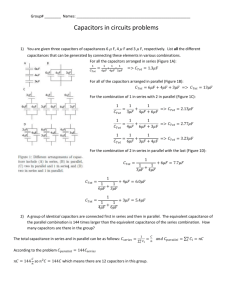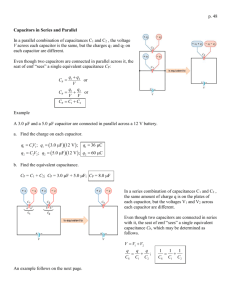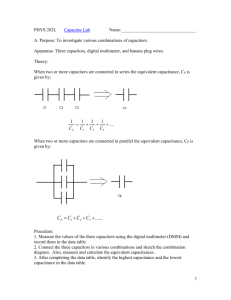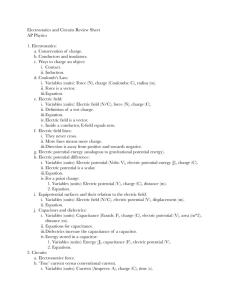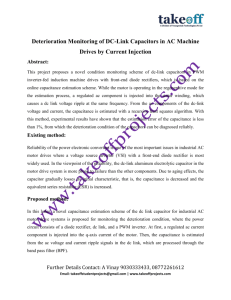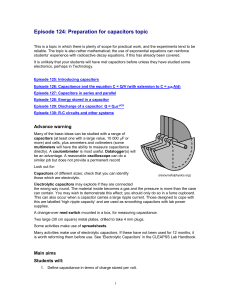القسم: العلوم الطبية التطبيقية
advertisement
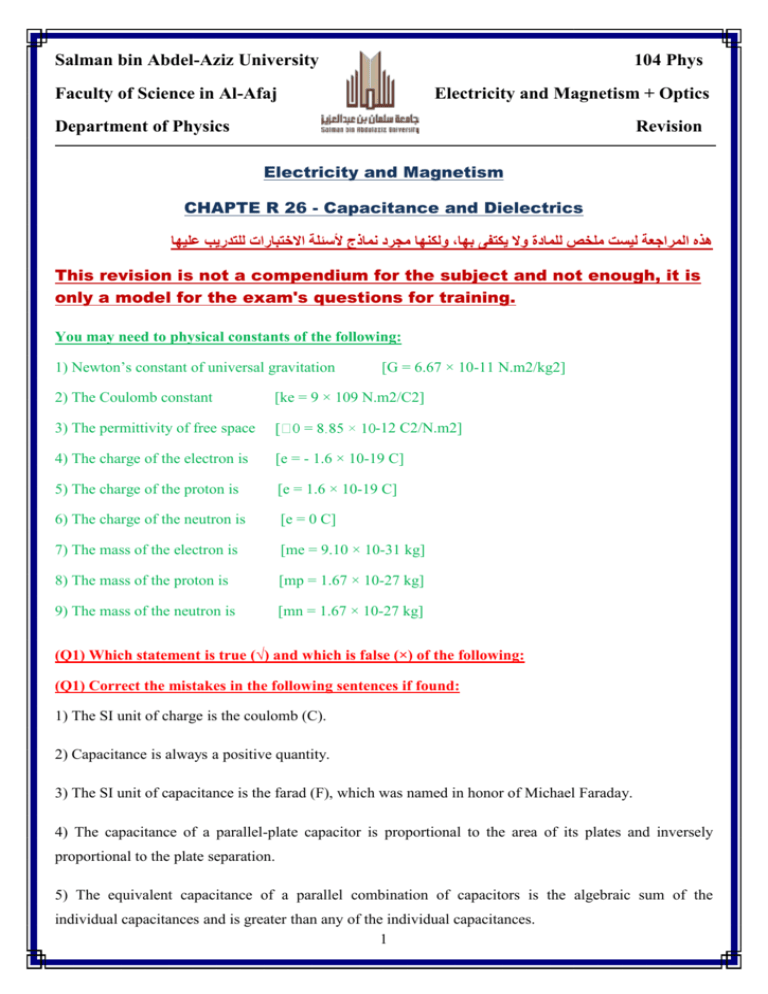
Salman bin Abdel-Aziz University 104 Phys Faculty of Science in Al-Afaj Electricity and Magnetism + Optics Department of Physics Revision Electricity and Magnetism CHAPTE R 26 - Capacitance and Dielectrics ولكنها مجرد نماذج ألسئلة االختبارات للتدريب عليها،هذه المراجعة ليست ملخص للمادة وال يكتفى بها This revision is not a compendium for the subject and not enough, it is only a model for the exam's questions for training. You may need to physical constants of the following: 1) Newton’s constant of universal gravitation 2) The Coulomb constant [G = 6.67 × 10-11 N.m2/kg2] [ke = 9 × 109 N.m2/C2] 3) The permittivity of free space -12 C2/N.m2] 4) The charge of the electron is [e = - 1.6 × 10-19 C] 5) The charge of the proton is [e = 1.6 × 10-19 C] 6) The charge of the neutron is [e = 0 C] 7) The mass of the electron is [me = 9.10 × 10-31 kg] 8) The mass of the proton is [mp = 1.67 × 10-27 kg] 9) The mass of the neutron is [mn = 1.67 × 10-27 kg] (Q1) Which statement is true (√) and which is false (×) of the following: (Q1) Correct the mistakes in the following sentences if found: 1) The SI unit of charge is the coulomb (C). 2) Capacitance is always a positive quantity. 3) The SI unit of capacitance is the farad (F), which was named in honor of Michael Faraday. 4) The capacitance of a parallel-plate capacitor is proportional to the area of its plates and inversely proportional to the plate separation. 5) The equivalent capacitance of a parallel combination of capacitors is the algebraic sum of the individual capacitances and is greater than any of the individual capacitances. 1 6) The equivalent capacitance of a parallel combination of capacitors is always larger than the individual capacitances. 7) When two or more capacitors are connected in parallel, the potential difference across each is the same. 8) The charge on each capacitor of a parallel combination of capacitors is proportional to its capacitance. 9) The individual potential differences across capacitors connected in parallel are the same and are equal to the potential difference applied across the combination. 10) The total charge on capacitors connected in parallel is the sum of the charges on the individual capacitors. 11) The charges on capacitors connected in series are the same. 12) The total potential difference across any number of capacitors connected in series is the sum of the potential differences across the individual capacitors. 13) The inverse of the equivalent capacitance of a series combination is the algebraic sum of the inverses of the individual capacitances and the equivalent capacitance of a series combination is always less than any individual capacitance in the combination. 14) The energy density in any electric field is proportional to the square of the magnitude of the electric field at a given point. (Q2) Choose the correct answer: 1) Many computer keyboard buttons are constructed of capacitors. When a key is pushed down, the soft insulator between the movable plate and the fixed plate is compressed. When the key is pressed, the capacitance a) increases b) decreases c) still the same d) data not enough 2) 1 F (farad) is equivalent to: a) 1 C/V b) 1 V/C c) 1 CV d) 1/CV b) 1×10-6 F c) 1×10-9 F d) 1×10-12 F b) 1×10-6 F c) 1×10-9 F d) 1×10-12 F 3) 1 F (microfarad) equals: a) 1×10-3 F 4) 1 pF (picofarad) equals: a) 1×10-3 F 2 5) Two capacitors are identical. They can be connected in series or in parallel. If you want the smallest equivalent capacitance for the combination, do you connect them in (a) in series (b) in parallel (c) do the combinations have the same capacitance? 6) Two capacitors are identical. Each capacitor is charged to a voltage of 10 V. If you want the largest combined potential difference across the combination, do you connect them in (a) in series (b) in parallel (c) do the combinations have the same potential difference? 7) You have three capacitors and a battery. In which of the following combinations of the three capacitors will the maximum possible energy be stored when the combination is attached to the battery? (a) series (b) parallel (c) Both combinations will store the same amount of energy. 8) A capacitor stores charge Q at a potential difference V. If the voltage applied by a battery to the capacitor is doubled to 2V, (a) the capacitance falls to half its initial value and the charge remains the same (b) the capacitance and the charge both fall to half their initial values (c) the capacitance and the charge both double (d) the capacitance remains the same and the charge doubles. 9) Capacitors can be made: a) Parallel-Plate b) Cylindrical c) Spherical d) all previous (Q3) Complete the missed words: ) ……………………………. of a capacitor is defined as the ratio of the magnitude of the charge on either conductor to the magnitude of the potential difference between the conductors. ) The Experiments showed that the quantity of charge Q on a capacitor is ……………….. proportional to the potential difference V between the conductors. * Choose the missed words from the following: (capacitance – capacitor c – charge – linearly – inversely) (Q4) Mention the measurement units of the following terms: 1) Capacitance 2) Electric charge 3) Potential difference 3 (Q5) Solve the following problems 1) A parallel-plate capacitor with air between the plates has an area A = 2×10-4 m2 and a plate separation d = 1 mm. Find its capacitance. (Q6) Define the following terms 1) Electric capacitance (Q7) Derivations questions: Derive the equivalent capacitance of a parallel combination of capacitors. Derive the equivalent capacitance of a series combination of capacitors. Prove that the inverse of the equivalent capacitance is the algebraic sum of the inverses of the individual capacitances and the equivalent capacitance of a series combination is always less than any individual capacitance in the combination. (Q8) Give the scientific terms of the following definitions: 1) A device consists of two conductors carrying charges of equal magnitude and opposite sign. 2) The ratio of the magnitude of the charge on either conductor of the capacitor to the magnitude of the potential difference between the conductors. 4

